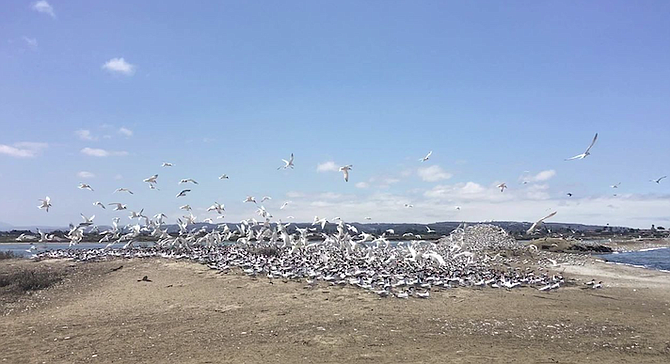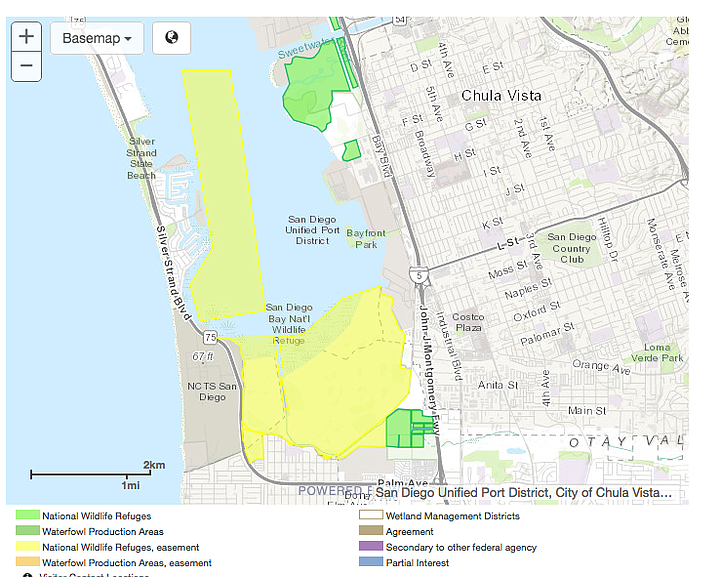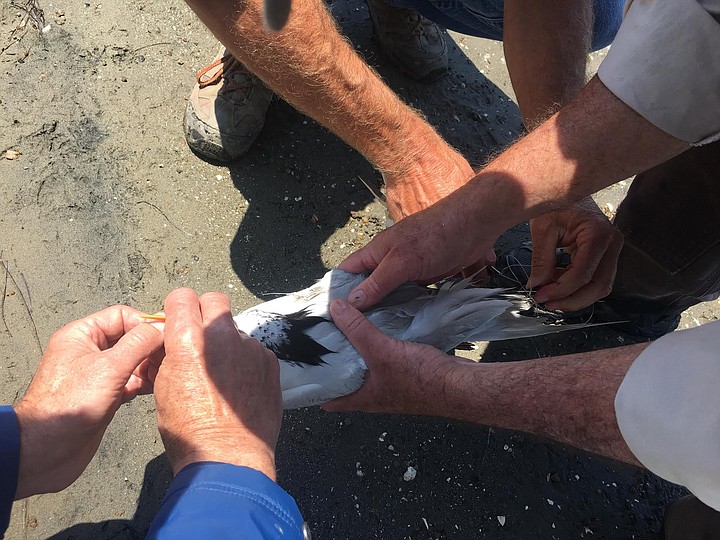 Facebook
Facebook
 X
X
 Instagram
Instagram
 TikTok
TikTok
 Youtube
Youtube

On June 6 at about 10:30 a.m., San Diegans and tourists might've seen the thousands of terns flying around at the San Diego Bay National Wildlife Refuge in Chula Vista.

The refuge is located west of the I-5 and E Street exit.
"Right now, we estimate there are almost 12,000 Elegant tern nests," said Lisa Cox of the refuge, "multiply that by two, and that’s about how many breeding adults we have."
Cox added that they have Royal terns, Caspian terns, Gull-billed terns, Forster's terns, and the federally threatened Western Snowy Plovers nesting on their refuge.

A video of a tern colony was posted on the refuge's Facebook page and it garnered about 60 reactions. "Welcome to the chaos of an active tern colony!" commented one viewer; another said "Well, there goes the neighborhood."
The video was filmed at the southern end of San Diego Bay.
"This area is operated under a special use permit by the South Bay Salt Works company," Cox said, "who manages the salt works system and levees that the birds nest on.
"The levees act as islands that the birds feel safe nesting on. However, they still have their natural predators such as Peregrine falcons, skunks, and other environmental factors to deal with."
The San Diego National Wildlife Refuge area consists of the Sweetwater Marsh (east side of San Diego Bay), which is 316 acres, and the South San Diego Bay Unit (southernmost tip of the San Diego Bay), which is 2,300acres.
"The terns will leave at different times after their chicks fledge," Cox said, "[at] around mid to late summer. Each species migrates to different areas, but generally after a post-breeding dispersal period when they may travel up an down the west coast, they generally head south for the winter. Food availability combined with disturbance levels at any given nesting location will dictate where and in what numbers each species members will choose to nest in a given location and season. Since these are fish eating birds for the most part, food availability depends on local fisheries conditions."
A couple of weeks ago, the refuge spotted a Royal tern that was floundering at the northern edge of the salt works. The tern had a hook in his wing which the team wasn't able to remove, so they contacted the avian veterinarians at SeaWorld.
"[Then] SeaWorld found a second hook lodged in his esophagus," Cox said, "so they had to do surgery. They have the facilities, the staff, the permits, and the equipment necessary to recover injured or sick wildlife. We couldn't have helped this bird without SeaWorld."
By June 12, the Royal tern healed and the refuge released him back to the colony.


On June 6 at about 10:30 a.m., San Diegans and tourists might've seen the thousands of terns flying around at the San Diego Bay National Wildlife Refuge in Chula Vista.

The refuge is located west of the I-5 and E Street exit.
"Right now, we estimate there are almost 12,000 Elegant tern nests," said Lisa Cox of the refuge, "multiply that by two, and that’s about how many breeding adults we have."
Cox added that they have Royal terns, Caspian terns, Gull-billed terns, Forster's terns, and the federally threatened Western Snowy Plovers nesting on their refuge.

A video of a tern colony was posted on the refuge's Facebook page and it garnered about 60 reactions. "Welcome to the chaos of an active tern colony!" commented one viewer; another said "Well, there goes the neighborhood."
The video was filmed at the southern end of San Diego Bay.
"This area is operated under a special use permit by the South Bay Salt Works company," Cox said, "who manages the salt works system and levees that the birds nest on.
"The levees act as islands that the birds feel safe nesting on. However, they still have their natural predators such as Peregrine falcons, skunks, and other environmental factors to deal with."
The San Diego National Wildlife Refuge area consists of the Sweetwater Marsh (east side of San Diego Bay), which is 316 acres, and the South San Diego Bay Unit (southernmost tip of the San Diego Bay), which is 2,300acres.
"The terns will leave at different times after their chicks fledge," Cox said, "[at] around mid to late summer. Each species migrates to different areas, but generally after a post-breeding dispersal period when they may travel up an down the west coast, they generally head south for the winter. Food availability combined with disturbance levels at any given nesting location will dictate where and in what numbers each species members will choose to nest in a given location and season. Since these are fish eating birds for the most part, food availability depends on local fisheries conditions."
A couple of weeks ago, the refuge spotted a Royal tern that was floundering at the northern edge of the salt works. The tern had a hook in his wing which the team wasn't able to remove, so they contacted the avian veterinarians at SeaWorld.
"[Then] SeaWorld found a second hook lodged in his esophagus," Cox said, "so they had to do surgery. They have the facilities, the staff, the permits, and the equipment necessary to recover injured or sick wildlife. We couldn't have helped this bird without SeaWorld."
By June 12, the Royal tern healed and the refuge released him back to the colony.
Comments